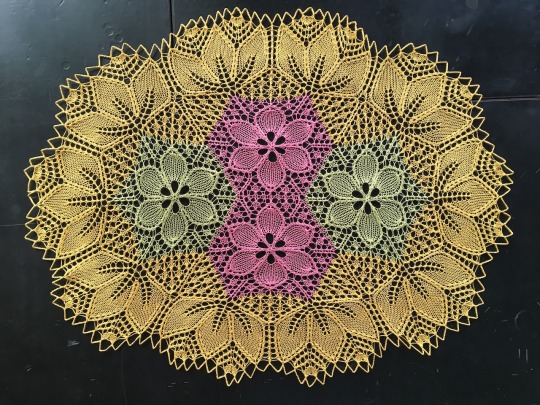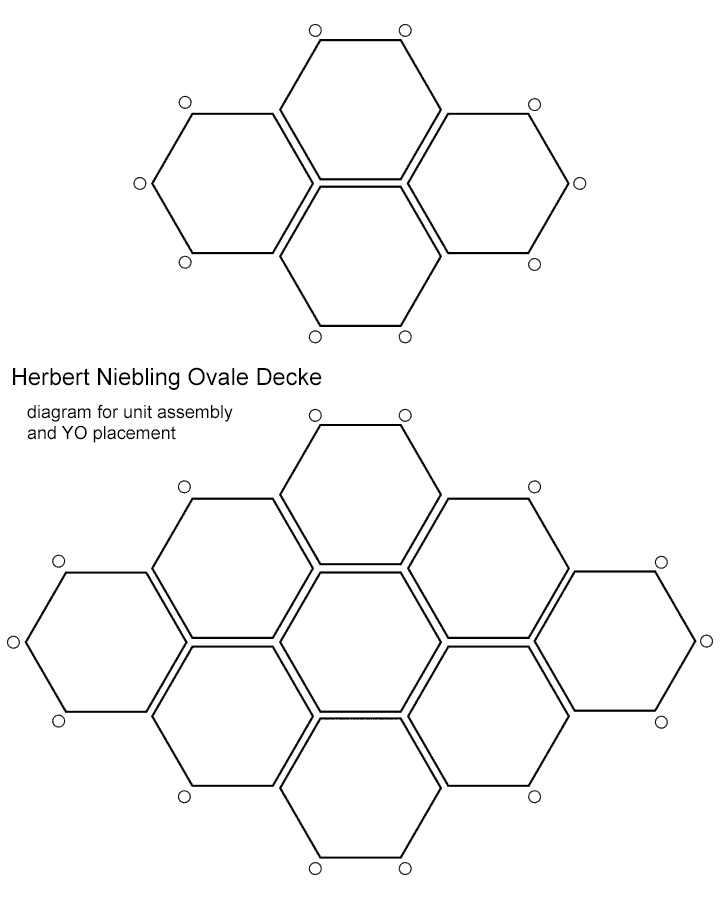#Herbert Niebling rides again
Text
Notes on the multicolored doily

Ovale Decke: Ravelry link, Ramona French charts
Knitted using three colors of crochet cotton, on US size 2 (2.75mm) needles. Finished dimensions about 24x18 inches.
The hexagonal units are reasonably straightforward to knit, although I had some questions about the chart. There’s a triple YO that turns into 7 stitches, which is clearly visible in pictures of the finished doily, but which is charted in a way that looks like it would result in two groups of three and a single stitch. Historic Niebling patterns tell you to alternate knits and purls in the same stitch for those huge increases, but I usually alternate knits and YOs instead. It makes fewer twists in the yarn.
Then there’s a round of purl stitches, and I can’t figure out why. The pictures from the original magazine don’t seem to have them, and some of the Ravelry projects don’t have them either, but some do. At what stage of things was this variation introduced? It is a mystery. I swatched it both ways, and decided to leave them out.
Ultimately, I made my own version of the chart, and used that. Here it is, for the record. In the hexagon chart, I included every round, because there are a couple of things that happen on even-numbered rounds, and I didn’t want to lose track of them. The border charts use the more standard notation of only showing odd-numbered rounds.

The 1x1 cable crosses may have all gone the same direction in the original, but I decided to mirror them, and also to not do them as actual cables. Instead, I did a mock cable that I think of as a Fake Decrease, but which is maybe officially called a Twisted Stitch (or Traveling Stitch?) and which I got very tired of by the time I was at the end of the border. All the border leaves are outlined in these crossed stitches as well. There are a lot of them. Bah.
I made four hexagonal units and grafted them together. Then I put all the remaining stitches onto a 24 inch needle, and considered the border.
The hexagon sides each have 17 stitches. In between the groups of 17, you either add a YO or you don’t, depending on whether that corner is convex or concave. I made a little diagram for both the 4-unit and the 9-unit versions, to show the placement of the in-between YOs.

I used several different colors of stitch markers to keep track of which places had the YOs and which ones didn’t. The YOs eventually expand into the triple-leaf shapes, but at first they’re easy to lose sight of.
I re-charted the border as two parts, A and B, and made a few small tweaks. When you’re using chart A, instead of repeating the chart exactly, you work whichever bits apply: the leaf increases happen at the corners where you’ve added a YO, and the former hexagon sides are gradually decreased away.

So you work rounds 1-8 of chart A, knitting any ktbl stitches through the back loop on the plain rounds as well. Starting with round 9, the part of the chart inside the orange outline gets repeated three times. Those sections get much wider very quickly, and it didn’t take very long before I had to switch to a 32 inch needle. And eventually to wish I had a 40 inch one.
On round 19, there are some places in between the leaf sections where there’s one stitch, and some places where there are two. To start chart B, you need three stitches in between the leaves, so you either do one YO (in between), or two YOs (one on either side). On round 20, I decided to knit those single in-between YOs through the back loop, because they seemed a bit too open and gappy. I suppose that more or less turns them into a M1.
I used two different double decreases, as follows:
The angled double decrease is slip 1 stitch, knit 2 together, pass the slipped stitch over: the central stitch ends up on the bottom of the stack, and the diagonal decrease lines are emphasized.
The centered double decrease is slip 2 stitches together knitwise, knit 1, pass both slipped stitches over: the central stitch ends up on top, and the vertical line is emphasized.
The 5-into-1 decrease goes like this: first you slip 2 stitches knitwise, exactly like you would for a ssk. Knit the next 2 stitches together, and pass one of the slipped stitches over. Then move the stitch over to the left needle, and pass the next working stitch over it. Move it back to the right needle, pass the other slipped stitch over it, and you’re done.
Chart B is pretty much normal lace knitting (except for the interminable 1x1 crossed stitches). After round 31, the marked groups of stitches are gathered with crochet chains in between.
The ones on Ravelry all seem to be diamond-shaped, but I blocked mine into more of an ellipse, and it’s kind of interesting to see how it distorted the central hexagons. Dealing with all the loose ends was exactly as terrible as you think it was. Writing the notes took nearly as long as the actual knitting. Hooray!

#knitting#doilies#in which I attempt to explain my methods#charts#long post#Herbert Niebling rides again
95 notes
·
View notes